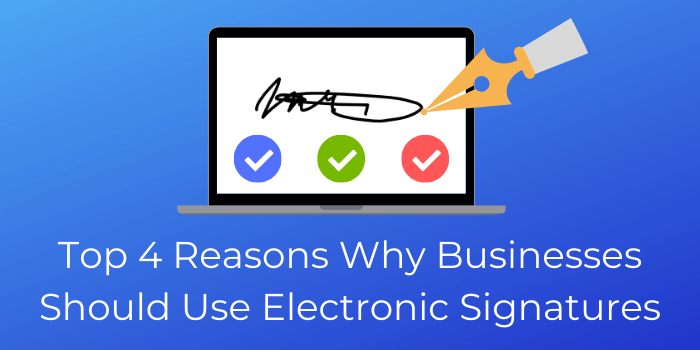Electronic signatures are becoming popular with more and more businesses looking for paperless solutions. The reason why businesses are going paperless is that it improves the efficiency of workflow, increase productivity, and save time. An electronic signature enables you to digitally sign an electronic document and validate a signer without having to visit that person.
The electronic signatures contain a unique set of data that is used for the purpose of identification. The electronic signature has the same legal standing as the signatures done with a pen. E-signatures are uniquely identifiable marks involving a cryptographic mechanism used to authenticate a document. Here are some reasons why you should use e-signatures for your business.

How Electronic Signatures Work
So, how do these electronic signatures work? It's pretty straightforward. You receive a document via email or through a signing platform. You open it, and there's a place marked for your signature. With a few simple steps, you add your signature - this could be by typing your name, drawing your signature with your mouse or using a saved digital signature.
Once you've done this, you hit 'send' or 'submit', and voila! The signed document is off to the next person. This process eliminates the need for physical handling of documents.
Behind the Times with Pen and Paper
Let's be real here. Sticking to pen and paper for signatures in this era is like preferring a horse-drawn carriage over a modern car. It's not just old-fashioned; it's impractical. Imagine the hassle: you get a document, print it, sign it, scan it, and then email it back. Or even worse, mail it and wait for who knows how long for a response.
With electronic signatures, all these steps are cut down to a simple click. So, hanging on to the pen-and-paper method isn't just old-school, it's a waste of time and resources.
Security and Efficiency: No Contest
When it comes to security and efficiency, electronic signatures are leagues ahead. Traditional signatures can be easily forged, lost in the mail, or even damaged. Electronic signatures, on the other hand, come with a secure digital trail. This includes who signed the document, when they signed it, and where they were. Plus, they're efficient. No more waiting for the mailman or worrying about a lost document. In contrast, insisting on a handwritten signature in this digital era seems not just outdated but a bit careless.
Environmental Impact: Think About the Trees
Think about the environmental impact. Every time you print a document for signing, that's a piece of paper used.
Over time, this adds up to a lot of wasted paper. Electronic signatures are a greener choice. They save trees and reduce your carbon footprint. So, if you're still using pen and paper, you're not just behind on technology, but also ignoring a more environmentally friendly option.

Behind the Times with Pen and Paper
Small Businesses and the Digital Leap
For small businesses, not adapting to electronic signatures is a big missed opportunity. In a world where speed and efficiency are key to staying competitive, clinging to outdated methods can hold you back.
Electronic signatures can streamline operations, reduce costs, and show your clients that you're up to date with technology. Refusing to make this change can give an impression of a business that's reluctant to adapt, potentially turning away tech-savvy clients.
Top 4 Reasons Why Businesses Should Use Electronic Signatures
Sticking to pen and paper for signatures seems more than just a little silly. It's inefficient, insecure, environmentally unfriendly, and sends the wrong message in a business context. Electronic signatures offer a smarter, quicker, and safer way to handle documents. So, it's high time to ditch the pen and embrace the click.
1. Convenience:
The modern business world is geographically dispersed, and even if you own a small business, you may have clients, suppliers, vendors, and partners located in different areas of a city, country, or state.
E-signatures offer convenience by allowing remote authentication. This means you no longer have to print, scan, or mail documents to your business partners and other concerned parties.
Real-Life Examples
Let's look at some real-life examples. Say you're a freelance designer. Your client sends you a contract for a new project. Instead of having to print and mail the contract, you both use electronic signatures. You sign it online, send it back, and the project starts sooner. Or imagine you're buying a house.
The amount of paperwork is overwhelming! With electronic signatures, you can sign all those documents from your home, without having to meet your realtor every time a signature is needed.
Benefits Beyond Convenience
Apart from the obvious convenience, electronic signatures offer other benefits. They're secure – often more secure than traditional signatures, as they come with a digital trail. This trail can include who signed the document, when they signed it, and where they were. Also, they're environmentally friendly – think about all the paper you're saving!
For Small Businesses
If you run a small business, electronic signatures can be a lifesaver. They're not just for big corporations. Imagine you're a small café owner who needs to sign supplier agreements. Using electronic signatures, you can quickly sign and return these documents.
This speeds up the process, ensuring you get your supplies on time without any hassle. Plus, it gives your business a modern, professional look.
2. Save Time and Effort:
It is a time-consuming process to get the traditional paper documents signed, especially if you have to get it by multiple parties or people. Depending on the location of the signer or signers, it can take a few days or weeks to get the documents signed by every party. With an electronic signature, you can get your document signed by multiple parties within a few minutes regardless of their geographical location.
Even if your signer is residing out of the country, signing the electronic document and receiving it back is a matter of a few minutes. This way, you can save a lot of time and effort and also save the hassle of storing, handling, and securing paper-based documents. Time is precious for a business. You can invest the saved time in other important matters to bring your business to the next level.
3. Improved Safety and Security:
Dealing with confidential paper documents also involves extra responsibility of keeping them secure as they are more likely to get destroyed, misplaced, misplaced, and much more. However, electronic signatures ensure extra security and safety for your important and confidential documents as they are secured by superior security protocols. The electronic signature keeps track of all the signing transactions to ensure the authentication and credibility of the signatures. Therefore, e-signatures offer improved security for your important business documents as they record the information on who signed the document.
4. Cost Saving:
Every penny you save in your business matters. By using electronic signatures, you will be saving costs on paper, printing, couriering, etc. Thus, you will work paperless, making your business operations more cost-friendly. Every little bit you save from using e-signatures will add up over the years. Thus, incorporating e-signatures into your business will save you a lot of money in the long run. Cost-saving is more crucial for small businesses.
Steps To Creating Your E-Signature

Creating your own electronic signature is pretty straightforward. Here's a step-by-step guide to get you started:
Step 1. Choose Your Method
First, decide how you want to create your signature. There are a few methods:
- Drawing on a Touchscreen: If you have a touchscreen device, you can use your finger or a stylus to draw your signature.
- Using a Mouse or Trackpad: You can draw your signature using your computer’s mouse or trackpad.
- Typing It Out: Some software allows you to type your name and convert it into a signature-like font.
- Scanning a Handwritten Signature: Write your signature on paper, scan it, and upload it to your computer.
Step 2. Use a Signature Creation Tool or Software
Many tools and software can help you create an electronic signature. Some common ones are;
- Adobe Acrobat
- DocuSign, and
- HelloSign.
These platforms often have a free version with basic features, which is enough for most people's needs.
Step 3. Draw or Type Your Signature
- If you're using a touchscreen or a mouse/trackpad, open the signature tool in the software and draw your signature. Try to make it look similar to your usual signature.
- If you're typing it, just type your name and select a font that looks closest to your handwriting.
Step 4. Save Your Signature
Once you're happy with how it looks, save your signature. The software will usually let you save it as an image file like a PNG or JPEG, or it might save within the software for future use.
Step 5. Test It Out
Now, test your signature by signing a digital document. Open a document that needs a signature, look for the option to insert a signature (usually found in the toolbar), and select your saved electronic signature. Place it in the designated signature area.
Step 6. Adjust Size and Position
After inserting your signature into the document, you might need to adjust its size and position to fit the designated area properly. Most software allows you to click and drag the corners of your signature to resize it.
Step 7. Finalize and Save the Document
Once your signature is in place and looks good, save the document. Now it's officially signed with your electronic signature!
Step 8. Keep It Secure
Remember, your electronic signature is legally binding, so keep it secure. Don't share it with others and make sure it's stored in a safe place on your device.
And that's it! You now have your electronic signature ready to use for signing documents digitally. This can save you a lot of time and hassle, especially when handling multiple documents that require your signature.
What Do You Advocate?

